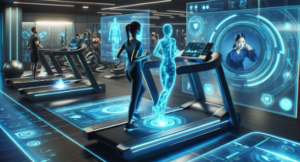
The fitness industry is experiencing a technological transformation, with Artificial Intelligence (AI) playing a central role. From personalized workout plans to virtual fitness coaching, AI has revolutionized how people approach health and wellness. This blog post delves into the multifaceted ways AI is shaping the fitness landscape, offering more efficient, customized, and accessible fitness solutions.
1. Personalized Training Programs
AI-driven fitness apps are capable of creating highly personalized workout routines tailored to an individual’s goals, fitness level, and preferences. Unlike generic workout plans, these AI systems analyze a user’s data—such as age, weight, fitness level, and even genetic predispositions—to create a workout regimen that maximizes results. For example, AI algorithms can adjust the intensity, duration, and type of exercise based on the user’s progress, providing a dynamic and responsive fitness plan.
These personalized programs often incorporate machine learning to continuously refine and adapt. For instance, if an app detects that a user is consistently failing to complete a certain exercise, it may suggest modifications or alternatives that better suit the user’s capabilities. This ongoing adaptation helps maintain motivation and reduces the risk of injury by ensuring that workouts are both effective and appropriate for the user’s current fitness level.
2. Virtual Personal Trainers
AI-powered virtual trainers provide an experience similar to working with a human personal trainer. Through computer vision and motion-sensing technology, these virtual trainers can analyze a user’s movements in real-time, providing immediate feedback on form and technique. This technology is particularly useful for at-home workouts, where users might not have access to professional guidance.
For example, AI-enabled cameras can monitor a user’s exercise form, identifying common mistakes such as improper squat technique or incorrect posture during a deadlift. The system then provides real-time corrections, helping users perform exercises safely and effectively. This not only improves workout efficiency but also reduces the risk of injury.
3. AI-Driven Nutrition Guidance
Fitness is not just about exercise; nutrition plays a crucial role in achieving fitness goals. AI has made significant strides in offering personalized nutrition advice that complements an individual’s workout routine. AI-powered apps can analyze dietary habits, monitor caloric intake, and even make meal suggestions based on a user’s dietary preferences, goals, and restrictions.
Advanced AI nutrition platforms can use natural language processing (NLP) to analyze a user’s food diary, offering insights and suggestions to improve dietary choices. Some apps also integrate with wearable devices to track physical activity, adjusting dietary recommendations based on the user’s activity level. For example, if the AI detects an intense workout session, it may suggest an increased protein intake for muscle recovery.
4. Wearable Fitness Technology
Wearable technology, such as smartwatches and fitness trackers, has become an integral part of the fitness ecosystem. These devices collect vast amounts of data, including heart rate, sleep patterns, activity levels, and more. AI plays a critical role in interpreting this data, providing users with actionable insights and recommendations.
Modern wearables equipped with AI can monitor biometric data in real-time, offering instant feedback and suggestions. For instance, if a user’s heart rate exceeds a certain threshold during a workout, the AI can recommend taking a break or switching to a less intense activity. Moreover, AI algorithms can analyze long-term data trends to identify patterns, such as the best time of day for the user to exercise based on their performance and recovery metrics.
5. Enhanced Group Fitness Experiences
AI is also enhancing group fitness experiences, making them more engaging and effective. In virtual group classes, AI can track each participant’s performance, providing feedback and encouragement tailored to individual needs. This level of personalization was previously impossible in traditional group settings, where instructors couldn’t feasibly provide individual attention to every participant.
For instance, AI can analyze each participant’s movement patterns in a virtual yoga class, offering personalized adjustments and modifications. This not only helps participants improve their form but also fosters a sense of individual achievement, even in a group environment. Furthermore, AI can use data analytics to create balanced workout routines that cater to the average fitness level of the group, ensuring that classes are challenging yet accessible.
6. AI and Mental Well-being
Mental health is an essential component of overall fitness, and AI is playing an increasingly important role in this area. Many fitness apps now incorporate AI-driven mindfulness and stress management tools. These tools can analyze user behavior, such as sleep patterns and activity levels, to identify signs of stress or burnout.
AI can provide personalized meditation and breathing exercises to help users manage stress. Some platforms even offer virtual therapy sessions with AI-powered chatbots trained in cognitive-behavioral techniques. By integrating mental well-being into fitness routines, AI ensures a more holistic approach to health, recognizing the interconnectedness of physical and mental wellness.
7. AI in Fitness Equipment
Fitness equipment manufacturers are integrating AI to create smart exercise machines. These machines can adapt to the user’s performance in real-time, adjusting resistance, speed, or incline to match the user’s capabilities and goals. For example, a smart treadmill with AI can automatically alter its speed and incline based on the user’s heart rate and exertion level, providing a customized and efficient workout.
Moreover, AI-powered equipment can track the user’s progress over time, offering insights into improvements in strength, endurance, and overall fitness. This data-driven approach helps users stay motivated by visualizing their progress and setting achievable goals.
8. The Future of AI in Fitness
The future of AI in fitness looks promising, with advancements that will further enhance the user experience. Emerging technologies like augmented reality (AR) and virtual reality (VR) combined with AI are set to create immersive fitness experiences. Imagine participating in a virtual marathon where AI adjusts the terrain and weather conditions to simulate a real-world race, providing a highly engaging workout experience.
Additionally, advancements in AI and biotechnology may soon allow for even deeper personalization. For example, AI could analyze a user’s genetic data to provide insights into optimal training methods and dietary plans tailored to their unique genetic makeup. This level of customization could lead to unprecedented levels of efficiency and effectiveness in achieving fitness goals.
Conclusion
AI is revolutionizing the fitness industry by offering personalized, efficient, and accessible solutions that cater to individual needs. From creating tailored workout programs and providing real-time coaching to offering personalized nutrition guidance and enhancing mental well-being, AI is transforming how people approach fitness and wellness. As technology continues to evolve, AI’s role in fitness will only grow, offering new possibilities for achieving optimal health in a world where personalized, data-driven experiences are becoming the norm.
By integrating AI into the fabric of fitness, we are not just automating workouts; we are redefining the entire fitness journey, making it more adaptable, intelligent, and in tune with the unique rhythms of each individual.
visit: gamicaltech.com
